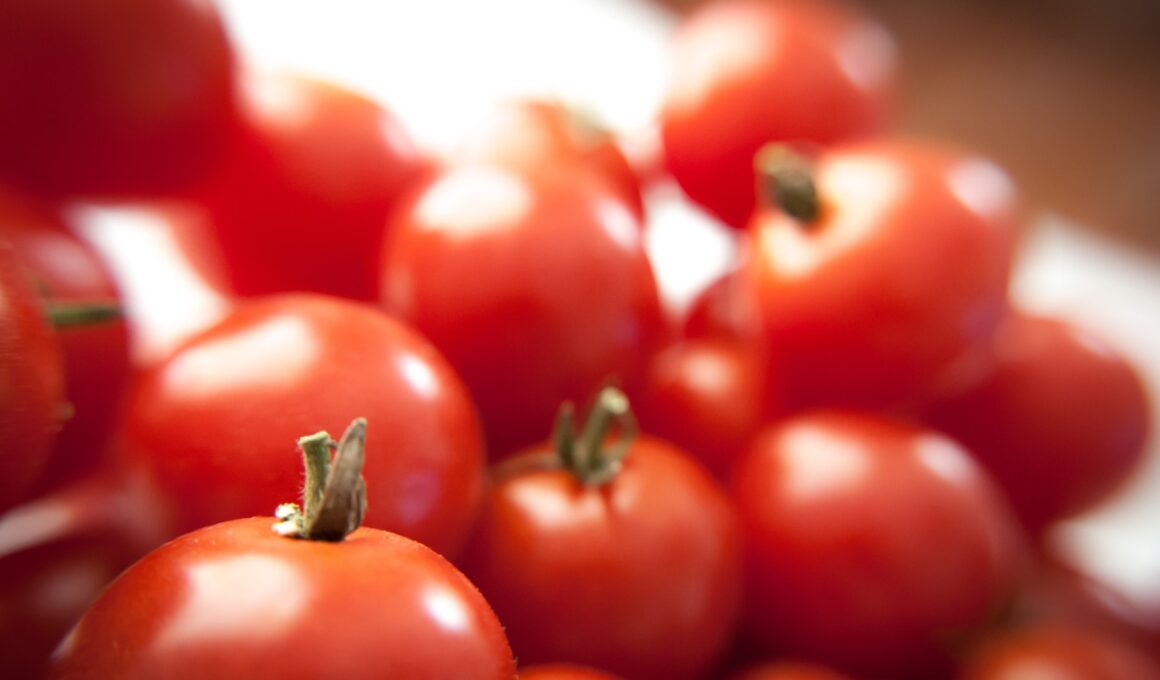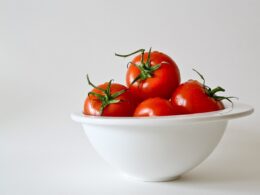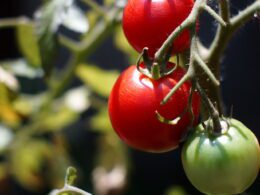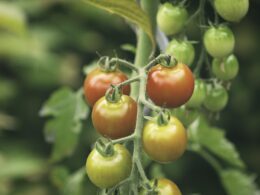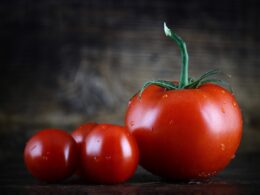You’ve put in the effort to grow your own tomato plants, and now you want to ensure they stay healthy and productive. One question that might be on your mind is whether or not you should avoid watering the leaves of your tomato plants.
You’re not alone – this is a topic that has sparked some debate among gardeners, as it’s crucial to provide the right care for your precious plants.
In this article, we’ll delve into the importance of proper watering techniques for tomatoes and discuss whether it’s best to keep those leaves dry or not. We’ll also cover common diseases and pests associated with wet leaves, share some best practices for keeping your tomato plants thriving, and offer general care tips that will help you maintain a safe and flourishing garden.
So let’s get started – it’s time to give our tomatoes the love and attention they deserve!
The Importance of Proper Watering Techniques
It’s crucial to master the art of watering your precious plants, as it can make all the difference in their growth and overall health. When it comes to tomatoes, using proper watering techniques is essential for not only producing a bountiful harvest but also keeping your plants safe from diseases.
By learning how to water correctly, you’ll ensure that your tomato plants receive the right amount of moisture they need without putting them at risk. One important aspect of watering tomatoes is focusing on the roots rather than the leaves. This means that you should aim to water directly onto the soil around your tomato plant instead of spraying or splashing water onto its leaves.
By doing this, you help prevent potential fungal infections and other diseases that thrive in damp environments – keeping your plants healthy and strong. So remember, when taking care of your tomato plants, always be mindful of how and where you’re watering them.
Avoiding wetting their leaves will go a long way in ensuring a healthier garden with less risk of disease. With proper attention to detail and technique, you can cultivate a beautiful crop of tomatoes while maintaining safety for both yourself and your beloved plants.
The Debate Over Watering Tomato Leaves
There’s quite a bit of controversy surrounding whether or not giving those juicy red veggies a sprinkle on the foliage is a good idea. Some gardeners swear by watering tomato leaves, while others insist on avoiding it at all costs. So, what’s the right answer?
The truth is, it depends on your specific situation and how you manage your garden. On one hand, watering tomato leaves can help keep them clean and free of dust, which may help with photosynthesis. However, wet leaves are also more susceptible to diseases like blight and other fungal infections that thrive in damp conditions.
To keep your tomatoes safe from these threats, avoid watering the leaves directly if possible. Instead, water at the base of the plant or use drip irrigation to minimize leaf moisture. That being said, sometimes Mother Nature doesn’t give us much choice when it comes to rainstorms soaking our plants from top to bottom.
In such cases, try to shake off excess water from the leaves or provide some airflow around your tomato plants to help them dry out faster. The key here is striking a balance between proper hydration for your tomatoes without creating an environment where diseases can easily take hold. Always be vigilant about signs of infection and address any issues promptly to ensure the safety and health of your beloved tomato plants!
Diseases and Pests Associated with Wet Leaves
Now let’s talk about the risks of wet leaves on your plants.
Fungal and bacterial infections can thrive in damp environments, leading to diseases that harm your plants.
Additionally, wet leaves attract insects, which may cause further damage to your garden.
So, it’s important to make sure your plants have adequate drainage and to remove any excess water from their leaves to prevent these issues from arising.
Fungal infections
Beware, my fellow gardeners, as fungal infections can wreak havoc on your precious plants when their foliage is drenched in water! Fungal spores love damp environments and can quickly multiply on wet leaves. If you’re not careful, these pesky fungi can spread throughout your tomato plants and ruin your hard work.
To keep your tomatoes safe from fungal infections, always water at the base of the plant and avoid getting those leaves wet. Also, be sure to provide proper air circulation around your plants so they dry off faster after rainfall or periods of high humidity.
Remember, prevention is key – protect your tomato plants from these invisible threats by being mindful of how you water them. Happy gardening!
Bacterial infections
Don’t let bacterial infections sneak up on your precious plants either, as they can cause just as much damage as fungal attackers! Bacterial infections often spread through splashing water, so avoiding watering tomato leaves is essential to keep these destructive microbes at bay. By taking a few simple precautions, you’ll protect your tomatoes and enjoy healthy, delicious fruits all season long.
Here are some tips to prevent bacterial infections in your tomatoes:
- Water at the base: Focus on watering the soil around the plant rather than spraying the foliage.
- Use drip irrigation: This method delivers water directly to the roots while keeping leaves dry.
- Mulch: Adding a layer of mulch helps retain moisture and reduces splashing when you water.
- Prune lower leaves: Remove any leaves touching the ground to minimize potential contact with bacteria.
- Rotate crops: Planting tomatoes in different areas of your garden each year reduces disease buildup in the soil.
By following these guidelines, you’ll be safeguarding your cherished tomato plants from harmful bacterial infections and ensuring a bountiful harvest!
Insect infestations
Insect infestations can wreak havoc on your tomato plants, but with a bit of vigilance and some helpful tips, you’ll be able to keep those pesky critters at bay.
One way to do this is by avoiding watering the leaves of your tomato plants. When the leaves are wet, it creates a welcoming environment for insects like aphids, whiteflies, and spider mites. These bugs love moisture and will quickly move in to feast on your precious tomatoes.
By keeping the foliage dry, you’re making it harder for these pests to thrive. To further protect your tomato plants from insect infestations, make sure to water them early in the day so that any moisture on the leaves has time to evaporate before nightfall when insects are most active.
You can also use a soaker hose or drip irrigation system which directs water straight to the roots instead of spraying it over the entire plant. This not only helps prevent insect infestations but also reduces the risk of diseases caused by wet leaves.
With these simple steps, you can help ensure your tomato plants stay healthy and safe from harmful pests!
Best Practices for Watering Tomato Plants
Imagine the thrill of nurturing your own plump, juicy tomatoes by mastering the art of watering them just right! Proper watering techniques not only ensure a healthy and bountiful harvest but also help prevent issues like insect infestations.
To keep your tomato plants happy and productive, follow these simple best practices:
-
Water at the base: Always water your tomato plants at their base rather than overhead to avoid wetting the leaves. This helps reduce the risk of fungal infections and encourages deep root growth.
-
Mulch around the plant: Applying a layer of mulch around your tomato plants helps retain moisture in the soil, reducing evaporation and keeping roots cool during hot weather.
-
Deep and infrequent watering: Water your tomatoes deeply but less frequently to encourage stronger root systems that can reach further into the soil for water and nutrients.
-
Monitor soil moisture: Be sure to check the moisture level in your garden regularly – ideally, you should be able to feel dampness when you dig about 2 inches below the surface.
By following these tips, you’re empowering yourself with knowledge that will lead to healthier tomato plants while protecting them from potential harm. Remember that consistency is key – make it a habit to routinely check on your garden’s needs so that you can quickly address any problems or adjust your watering schedule as necessary.
As you continue implementing these best practices for watering tomato plants, take pride in knowing that you’re fostering an environment where both safety and productivity thrive hand-in-hand!
General Tomato Care Tips
Now that we’ve covered watering techniques, let’s dive into some general tomato care tips to ensure your plants flourish and provide a bountiful harvest!
First things first, choose the right spot for planting. Tomatoes thrive in well-draining soil with plenty of sunlight – at least six hours a day. If you’re planting them in containers, make sure there’s enough space for their roots to grow and avoid overcrowding.
Next up is fertilizing your tomato plants. A balanced fertilizer with equal parts nitrogen, phosphorus, and potassium is ideal for promoting healthy growth. However, be cautious not to over-fertilize as this can lead to excessive foliage and fewer fruits.
It’s also important to keep an eye out for pests like aphids, whiteflies, or hornworms that may damage your plants – using insecticidal soap or introducing beneficial insects like ladybugs can help keep those pesky critters at bay.
To support your tomato plants as they grow taller and heavier with fruit, consider staking or caging them early on in their development. This will not only prevent the plant from bending under its own weight but also reduce the risk of disease by keeping leaves off the ground.
Remember to prune any suckers (small shoots growing between the main stem and branches) regularly so that energy goes towards producing bigger tomatoes instead of unnecessary foliage.
With these care tips in mind, you’ll be well on your way to enjoying delicious homegrown tomatoes all season long!
Conclusion
So, should you avoid watering tomato leaves? Absolutely! It’s crucial to keep those leaves dry to prevent diseases and pests. Stick to watering the soil instead.
Remember, proper care for your tomatoes is essential for a bountiful harvest. Follow the best practices and watch your garden thrive!





